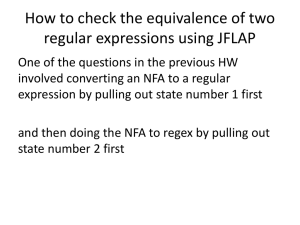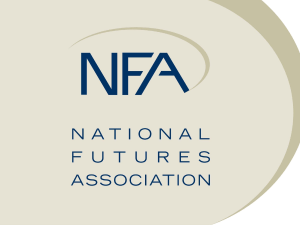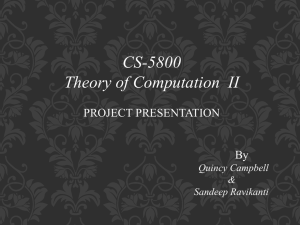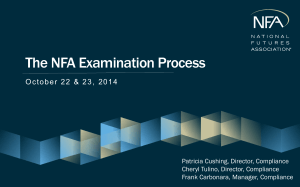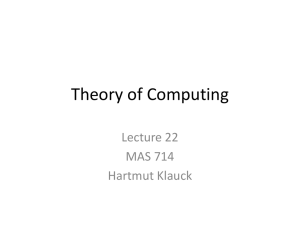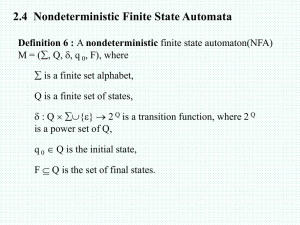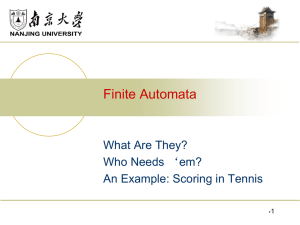PPT - The Stanford University InfoLab
advertisement
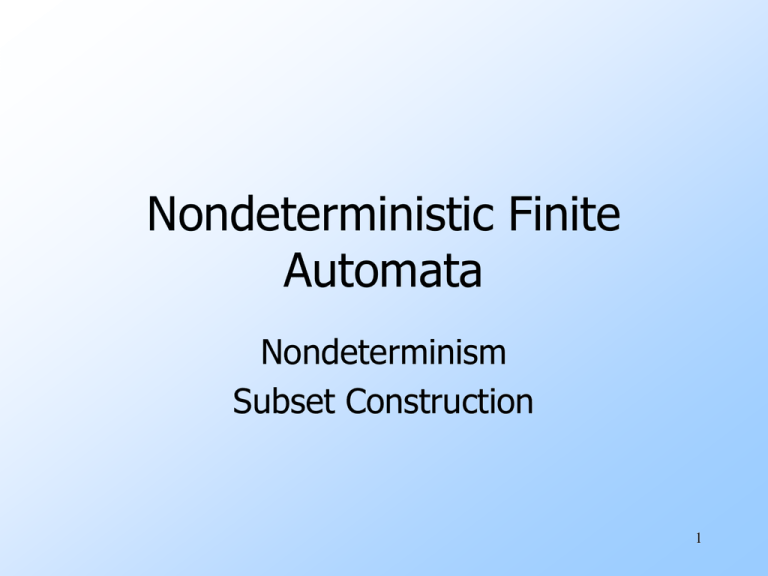
Nondeterministic Finite
Automata
Nondeterminism
Subset Construction
1
Nondeterminism
A nondeterministic finite automaton
has the ability to be in several states at
once.
Transitions from a state on an input
symbol can be to any set of states.
2
Nondeterminism – (2)
Start in one start state.
Accept if any sequence of choices leads
to a final state.
Intuitively: the NFA always “guesses
right.”
3
Example: Moves on a
Chessboard
States = squares.
Inputs = r (move to an adjacent red
square) and b (move to an adjacent
black square).
Start state, final state are in opposite
corners.
4
Example: Chessboard – (2)
1
2
3
4
5
6
7
8
9
r
1
b
2
4
b
1
3
5
7
5
1
3
7
9
1
2
3
4
5
6
7
8
* 9
r
2,4
4,6
2,6
2,8
2,4,6,8
2,8
4,8
4,6
6,8
b
5
1,3,5
5
1,5,7
1,3,7,9
3,5,9
5
5,7,9
5
5
Accept, since final state reached
Formal NFA
A finite set of states, typically Q.
An input alphabet, typically Σ.
A transition function, typically δ.
A start state in Q, typically q0.
A set of final states F ⊆ Q.
6
Transition Function of an NFA
δ(q, a) is a set of states.
Extend to strings as follows:
Basis: δ(q, ε) = {q}
Induction: δ(q, wa) = the union over
all states p in δ(q, w) of δ(p, a)
7
Language of an NFA
A string w is accepted by an NFA if
δ(q0, w) contains at least one final
state.
The language of the NFA is the set of
strings it accepts.
8
Example: Language
of an NFA
1
2
3
4
5
6
7
8
9
For our chessboard NFA we saw that
rbb is accepted.
If the input consists of only b’s, the set
of accessible states alternates between
{5} and {1,3,7,9}, so only even-length,
nonempty strings of b’s are accepted.
What about strings with at least one r?
9
Equivalence of DFA’s, NFA’s
A DFA can be turned into an NFA that
accepts the same language.
If δD(q, a) = p, let the NFA have
δN(q, a) = {p}.
Then the NFA is always in a set
containing exactly one state – the state
the DFA is in after reading the same
input.
10
Equivalence – (2)
Surprisingly, for any NFA there is a DFA
that accepts the same language.
Proof is the subset construction.
The number of states of the DFA can
be exponential in the number of states
of the NFA.
Thus, NFA’s accept exactly the regular
languages.
11
Subset Construction
Given an NFA with states Q, inputs Σ,
transition function δN, state state q0, and
final states F, construct equivalent DFA
with:
States 2Q (Set of subsets of Q).
Inputs Σ.
Start state {q0}.
Final states = all those with a member of F.
12
Critical Point
The DFA states have names that are
sets of NFA states.
But as a DFA state, an expression like
{p,q} must be read as a single symbol,
not as a set.
Analogy: a class of objects whose
values are sets of objects of another
class.
13
Subset Construction – (2)
The transition function δD is defined by:
δD({q1,…,qk}, a) is the union over all i =
1,…,k of δN(qi, a).
Example: We’ll construct the DFA
equivalent of our “chessboard” NFA.
14
Example: Subset Construction
1
2
3
4
5
6
7
8
* 9
r
2,4
4,6
2,6
2,8
2,4,6,8
2,8
4,8
4,6
6,8
b
5
1,3,5
5
1,5,7
1,3,7,9
3,5,9
5
5,7,9
5
{1}
{2,4}
{5}
r
{2,4}
b
{5}
Alert: What we’re doing here is
the lazy form of DFA construction,
where we only construct a state
15
if we are forced to.
Example: Subset Construction
1
2
3
4
5
6
7
8
* 9
r
2,4
4,6
2,6
2,8
2,4,6,8
2,8
4,8
4,6
6,8
b
5
1,3,5
5
1,5,7
1,3,7,9
3,5,9
5
5,7,9
5
{1}
{2,4}
{5}
{2,4,6,8}
{1,3,5,7}
r
b
{2,4}
{5}
{2,4,6,8} {1,3,5,7}
16
Example: Subset Construction
1
2
3
4
5
6
7
8
* 9
r
2,4
4,6
2,6
2,8
2,4,6,8
2,8
4,8
4,6
6,8
b
5
1,3,5
5
1,5,7
1,3,7,9
3,5,9
5
5,7,9
5
{1}
{2,4}
{5}
{2,4,6,8}
{1,3,5,7}
* {1,3,7,9}
r
b
{2,4}
{5}
{2,4,6,8} {1,3,5,7}
{2,4,6,8} {1,3,7,9}
17
Example: Subset Construction
1
2
3
4
5
6
7
8
* 9
r
2,4
4,6
2,6
2,8
2,4,6,8
2,8
4,8
4,6
6,8
b
5
1,3,5
5
1,5,7
1,3,7,9
3,5,9
5
5,7,9
5
r
b
{1}
{2,4}
{5}
{2,4}
{2,4,6,8} {1,3,5,7}
{5}
{2,4,6,8} {1,3,7,9}
{2,4,6,8} {2,4,6,8} {1,3,5,7,9}
{1,3,5,7}
* {1,3,7,9}
* {1,3,5,7,9}
18
Example: Subset Construction
1
2
3
4
5
6
7
8
* 9
r
2,4
4,6
2,6
2,8
2,4,6,8
2,8
4,8
4,6
6,8
b
5
1,3,5
5
1,5,7
1,3,7,9
3,5,9
5
5,7,9
5
r
{1}
{2,4}
{2,4}
{2,4,6,8}
{5}
{2,4,6,8}
{2,4,6,8} {2,4,6,8}
{1,3,5,7} {2,4,6,8}
* {1,3,7,9}
* {1,3,5,7,9}
b
{5}
{1,3,5,7}
{1,3,7,9}
{1,3,5,7,9}
{1,3,5,7,9}
19
Example: Subset Construction
1
2
3
4
5
6
7
8
* 9
r
2,4
4,6
2,6
2,8
2,4,6,8
2,8
4,8
4,6
6,8
b
5
1,3,5
5
1,5,7
1,3,7,9
3,5,9
5
5,7,9
5
r
{1}
{2,4}
{2,4}
{2,4,6,8}
{5}
{2,4,6,8}
{2,4,6,8} {2,4,6,8}
{1,3,5,7} {2,4,6,8}
* {1,3,7,9} {2,4,6,8}
* {1,3,5,7,9}
b
{5}
{1,3,5,7}
{1,3,7,9}
{1,3,5,7,9}
{1,3,5,7,9}
{5}
20
Example: Subset Construction
1
2
3
4
5
6
7
8
* 9
r
2,4
4,6
2,6
2,8
2,4,6,8
2,8
4,8
4,6
6,8
b
5
1,3,5
5
1,5,7
1,3,7,9
3,5,9
5
5,7,9
5
{1}
{2,4}
{5}
{2,4,6,8}
{1,3,5,7}
* {1,3,7,9}
* {1,3,5,7,9}
r
{2,4}
{2,4,6,8}
{2,4,6,8}
{2,4,6,8}
{2,4,6,8}
{2,4,6,8}
{2,4,6,8}
b
{5}
{1,3,5,7}
{1,3,7,9}
{1,3,5,7,9}
{1,3,5,7,9}
{5}
{1,3,5,7,9}
21
Proof of Equivalence: Subset
Construction
The proof is almost a pun.
Show by induction on |w| that
δN(q0, w) = δD({q0}, w)
Basis: w = ε: δN(q0, ε) = δD({q0}, ε) =
{q0}.
22
Induction
Assume IH for strings shorter than w.
Let w = xa; IH holds for x.
Let δN(q0, x) = δD({q0}, x) = S.
Let T = the union over all states p in S of
δN(p, a).
Then δN(q0, w) = δD({q0}, w) = T.
For NFA: the extension of δN.
For DFA: definition of δD plus extension of δD.
• That is, δD(S, a) = T; then extend δD to w = xa.
23
NFA’s With ε-Transitions
We can allow state-to-state transitions
on ε input.
These transitions are done
spontaneously, without looking at the
input string.
A convenience at times, but still only
regular languages are accepted.
24
Example: ε-NFA
ε
1
B
ε
A
0
E
1
C
ε
0
1
0
F
D
A
B
C
* D
E
F
0
1
ε
{E} {B} ∅
∅ {C} {D}
∅ {D} ∅
∅ ∅ ∅
{F} ∅ {B, C}
{D} ∅ ∅
25
Closure of States
CL(q) = set of states you can reach
from state q following only arcs labeled
ε.
ε
Example: CL(A) = {A};
CL(E) = {B, C, D, E}.
1
A
0
B 1 C 1
ε
E
ε
0
F
D
0
Closure of a set of states = union of
the closure of each state.
26
Extended Delta
˄
Basis: δ (q, ε) = CL(q).
˄
Induction: δ(q, xa) is computed as
follows:
˄
1. Start with δ(q, x) = S.
2. Take the union of CL(δ(p, a)) for all p in S.
˄
Intuition: δ (q, w) is the set of states
you can reach from q following a path
labeled w.
And notice that δ(q, a) is not
that set of states, for symbol a.
27
Example:
Extended Delta
˄
ε
1
A
0
B 1 C 1
ε
E
ε
0
F
D
0
δ(A, ε) = CL(A) = {A}.
˄
δ(A, 0) = CL({E}) = {B, C, D, E}.
˄
δ(A, 01) = CL({C, D}) = {C, D}.
Language of an ε-NFA
is
the
set
of
˄
strings w such that δ(q0, w) contains a
final state.
28
Equivalence of NFA, ε-NFA
Every NFA is an ε-NFA.
It just has no transitions on ε.
Converse requires us to take an ε-NFA
and construct an NFA that accepts the
same language.
We do so by combining ε–transitions
with the next transition on a real input.
Warning: This treatment is a
bit different from that in the text.
29
Picture of ε-Transition Removal
a
a
Transitions
on ε
a
Transitions
on ε
30
Picture of ε-Transition Removal
To here, and performs
the subset construction
Text goes
from here
a
a
Transitions
on ε
a
Transitions
on ε
31
Picture of ε-Transition Removal
To here, with no
subset construction
a
We’ll go
from here
Transitions
on ε
a
a
Transitions
on ε
32
Equivalence – (2)
Start with an ε-NFA with states Q,
inputs Σ, start state q0, final states F,
and transition function δE.
Construct an “ordinary” NFA with states
Q, inputs Σ, start state q0, final states
F’, and transition function δN.
33
Equivalence – (3)
Compute δN(q, a) as follows:
1. Let S = CL(q).
2. δN(q, a) is the union over all p in S of
δE(p, a).
F’ = the set of states q such that
CL(q) contains a state of F.
Intuition: δN incorporates ε–transitions
before using a but not after.
34
Equivalence – (4)
Prove by induction on |w| that
˄
CL(δN(q0, w)) = δ E(q0, w).
Thus, the ε-NFA accepts w if and only if
the “ordinary” NFA does.
35
Interesting
closures: CL(B)
= {B,D}; CL(E)
= {B,C,D,E}
A
B
C
* D
E
F
0
1
ε
{E} {B} ∅
∅ {C} {D}
∅ {D} ∅
∅ ∅ ∅
{F} ∅ {B, C}
{D} ∅ ∅
Example: ε-NFAto-NFA
A
* B
C
* D
* E
F
ε-NFA
Since closures of
B and E include
final state D.
0
1
{E} {B}
∅ {C}
∅ {D}
∅ ∅
{F} {C, D}
{D} ∅
Since closure of
E includes B and
C; which have
transitions on 1
36
to C and D.
Summary
DFA’s, NFA’s, and ε–NFA’s all accept
exactly the same set of languages: the
regular languages.
The NFA types are easier to design and
may have exponentially fewer states
than a DFA.
But only a DFA can be implemented!
37
